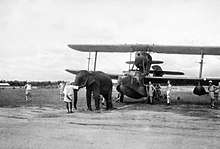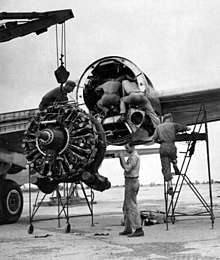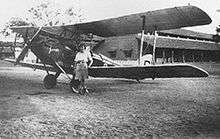Aviation in India
Aviation in India, broadly divided into military and civil aviation, is the fastest-growing aviation market in the world (IATA data) and Bangalore with 65% national share is the largest aviation manufacturing hub of India.[1] UDAN scheme is driving the growth of civil aviation connectivity and infrastructure in India.
History
.jpg)
On 18 February 1911, the first commercial civil aviation flight took off from Allahabad for Naini over a distance of 6 miles (9.7 km) when Henri Pequet, a French aviator, carried 6,500 pieces of mail on a Humber biplane from the exhibition to the receiving office at Allahabad which was the world's first official airmail service.[2] On 15 October 1932, J.R.D. Tata flew a consignment of mail from Karachi to Juhu Airport, an airline later became Air India.[3]
Type of aviation
Military aviation


Market size
In its publication the Military Balance 2010, the International Institute for Strategic Studies (IISS) estimated that the Indian Air Force has a strength of 127,000 active personnel. However, various reliable sources provided notably divergent estimates of its strength over the years. Flightglobal (Flight International) estimates there to be around 1,820 aircraft in service with the IAF: 905 combat planes, 595 fighters and 310 attackers.[4] The defense sector, Indian Airforce, and HAL are investing billions of rupees for the development of numerous indigenous fighter aircraft and new technologies in the aviation industry. HAL Tejas, India’s newly built indigenous fighter aircraft, is one of the best examples of government initiative’s success.[5]
Management
The President of India serves as the ex-officio Commander-in-Chief of the IAF. The Chief of Air Staff, an Air Chief Marshal (ACM), is a four-star commander and commands the Air Force. There is never more than one serving ACM in the IAF at any given time. The rank of Marshal of the Air Force has been conferred once, to Arjan Singh, by the President of India on 26 January 2002, and Singh became the first five-star rank-holding officer of the IAF and serves as its ceremonial chief.
Branches
The Indian Air Force, Indian Naval Air Arm and Army Aviation Corps are the air arms of the Indian armed forces. The Indian Air Force is the world's 4th largest air force with primary responsibility for securing Indian airspace and to conduct aerial warfare during a conflict. It was officially established on 8 October 1932 as an auxiliary air force of the British Empire, and the prefix Royal was added in 1945 in recognition of its services during World War II. Following the Indian Independence Act 1947, the new states of India and Pakistan became independent from the United Kingdom, the Royal Indian Air Force served the Dominion of India, with the prefix being dropped when India became a republic in 1950. Since independence, the IAF has been involved in four wars with neighbouring Pakistan and one with the People's Republic of China.[6] Other major operations undertaken by the IAF include Operation Vijay, Operation Meghdoot, Operation Cactus, Operation Poomalai and Operation Raahat. Apart from conflicts in the subcontinent, the IAF has been an active participant in United Nations peacekeeping missions.
Civil aviation

IndiGo, Jet Airways, Air India, Spicejet and GoAir are the major carriers in order of their market share.[7] These airlines connect more than 80 cities across India and also operate overseas routes after the liberalisation of Indian aviation. Several other foreign airlines connect Indian cities with other major cities across the globe. However, a large section of country's air transport potential remains untapped, even though the Mumbai-Delhi air corridor was ranked 10th by Amadeus in 2012 among the world's busiest routes.[8][9]
Market size
India is the world's third-largest domestic and overall civil aviation market (c. January 2018).[10][11] The number of air passengers grew 16.3% annually from 14 million (1.40 crores in 2000–01) to 135 million (13.5 crores in 2015-16, both domestic and international).[12] It recorded an air traffic of 131 million passengers in 2016, estimated to be 60 million international passengers by 2017. The market is also estimated to have 800 aircraft by 2020.[13] In 2015, Boeing projected India's demand for aircraft to touch 1,740 or 4.3% of global volume, valued at $240 billion, over the next 20 years in India.[14]
Management and regulation
Ministry of Civil Aviation is responsible for civilian aviation and Ministry of Defence is responsible for the Indian Air Force. National Civil Aviation Policy 2016 covers the broad policy areas, such as Regional connectivity, Safety, Air Transport Operations, 5/20 Requirement for International Operations, Bilateral traffic rights, Fiscal Support, Maintenance, Repair and Overhaul, Air-cargo, Aeronautical Make in India.[15] Under the UDAN scheme, the government is planning to develop a sustainable air network in over 400 tier-2 cities across India with an estimated expenditure of ₹50 crore (US$7.0 million).[16][17][18][19][20][21][22]
Infrastructure

India was targeting 486 existing airports as potential airport for UDAN-RCS, including 406 Unserved airports,[23] 18 Underserved RCS airports (mostly tier-2 regional cities),[24] and 62 NON-RCS airports participating in RCS, mostly tier-2 major city airports or customs airports in tier-2 cities (Dec 2017).[25] In addition, AAI granted in-principal approval to 19 new airports in Dec 2017.[26]
In Dec 2017, total operational civil aviation airports in India increased 34% to 131 airports (106 with scheduled civilian flights including some with dual civilian and army use, 3 newly made operational) after the commencement of UDAN-RCS Phase-I (Dec 2017),[27] from the previous figure of 98 total operational airports in 2016 (including 70 civilian airports and the rest army airports with civilian enclaves).[27]
Among the busiest airports in India, the Indira Gandhi International Airport which serves as the primary civilian aviation hub for the National Capital Region of Delhi,[28] is the busiest airport in the country in terms of passenger traffic and international traffic busiest airport in India since 2009 and the second busiest airport in the country in terms of cargo traffic after Mumbai.[29] With the commencement of operations at Terminal 3 in 2010, it became India's and South Asia's largest aviation hub, with a current capacity of handling more than 40 million passengers, which will go up to 100 million passengers by 2030 with the planned expansion.[30] It was 12th busiest airports in Asia (2014) and 21st busiest airport in the world by passenger traffic (2016).
Several Integrated Aviation-industrial parks, for aerospace training, research, manufacturing, Maintenance, repair, and operations (MRO) and Fixed-base Operations (FBO) integrated international aviation hub and aerospace industrial hub, are in the process of being setup, such as in Hisar[31][32][33] and Gujarat.[34]
There are a total of 22 airlines which are operational in India, including Air India and Pawan Hans PSUs, listed companies (SpiceJet, IndiGo Airlines, Jet Lite, Air India Express and Jet Airways) and private airlines (such as GoAir, Air Asia, Vistara and IndiGo) (c. 2015). Number of civil aviation aircraft in operation for the scheduled commercial flights jumped 38% to 548 in Dec 2017 from 395 in 2014 and 50 aircraft are being added every year.[26]
In September 2018, Civil Aviation Minister said that as many as 100 new airports would be built in the next 10 to 15 years for about $60 billion to meet the growing domestic air travel demand.[35][36]
See also
References
Citations
- ↑ India crowned world's fastest growing aviation market in 2015 as economy takes off, The Telegraph, 1 January 2016.
- ↑ "100 Years of Civil Aviation in India - Milestones", PIB
- ↑ Beginning of Aviation in India - Bharat Rakshak Archived 27 February 2012 at the Wayback Machine.
- ↑ "Flightglobal - World Air Forces 2015 (PDF), Flightglobal.com" (PDF). d1fmezig7cekam.Cloudfront.net. Retrieved 9 January 2018.
- ↑ https://campushunt.in (28 September 2017). "Best BBA Aviation & Airport Management Colleges in Bangalore - Career, Scope, Job, Salary Details". CampusHunt.in. Retrieved 9 January 2018.
- ↑ List of wars involving India
- ↑ "Mumbai-Delhi 10th busiest air route". Times of India. 12 May 2012. Retrieved 5 September 2012.
- ↑ "Mumbai airport's traffic control tower design bags award". Thaindian.com. 21 July 2009. Retrieved 16 August 2010.
- ↑ In next 6-8 months, we expect to get bids for Air India: Jayant Sinha, Economic Times, 8 January 2018.
- ↑ "India becomes 3rd largest aviation market in domestic traffic - Times of India". IndiaTimes.com. Retrieved 9 January 2018.
- ↑ "Indian aviation is flying high". DailyExcelsior.com. 17 March 2017. Retrieved 9 January 2018.
- ↑ Aviation, Make in India
- ↑ India emerging biggest aircraft market
- ↑ indiainfoline.com. "Govt releases National Civil Aviation Policy; impact of FDI in Aviation sector". IndiaInfoline.com. Retrieved 9 January 2018.
- ↑ "Air connectivity for tier-2 cities soon, says MoS Civil Aviation Mahesh Sharma", India Today, 9 February 2016
- ↑ "GoI AAI's RCS UDAN document (final version), October 2016" (PDF). AAI.aero. Retrieved 9 January 2018.
- ↑ "Ude Desh Ka Aam Naagrik : Civil Aviation Ministry's Regional Connectivity Scheme "UDAN" Launched Today". Press Information Bureau. Government of India. October 21, 2016.
- ↑ Shukla, Tarun (6 March 2017). "Govt clears Rs4,500 crore for 50 regional airports under Udan scheme". LiveMint.com. Retrieved 9 January 2018.
- ↑ "UDAN: Govt links airlines' performance to award of more routes.", Economic Times, 14 November 2017.
- ↑ "Udan scheme round-II: Government receives 141 proposals for air routes.", Zee Business, 14 November 2017.
- ↑ Regional Connectivity Scheme – UDAN (PDF) (Report). Ministry of Civil Aviation – Government of India. October 2016. Retrieved 31 March 2017.
- ↑ Participating unserved UDAN-RCS airports, Airport Authority of India, Nov 2016.
- ↑ Underserved participating airports at the beginning of UDAN-RCS, Airport Authority of India, Nov 2016.
- ↑ Non-RCS airports including well served airports, Airport Authority of India, Nov 2016
- 1 2 In-principle approval for 19 greenfield airports given: Raju, Times of India, 20 December 2017.
- 1 2 State police to stand guard at Airports under UDAN scheme, Economic Times, 2 Dec 2015.
- ↑ "eAIP India AD-2.1 VIDP". Aai.aero. Retrieved 5 May 2014.
- ↑ "Delhi Airport busier than Mumbai by 40 flights a day". Indianexpress.com. 16 August 2009. Retrieved 5 May 2014.
- ↑ Grammaticas, Damian (9 May 2007). "Sky's the limit for India flight boom". BBC News. Retrieved 5 May 2014.
- ↑ Vijay Mohan. Army’s helicopter repair hub likely to come up in Hisar, The Tribune, 1 August 2016.
- ↑ Haryana to develop international airport at Hisar, TravelBizMonitor, Retrieved in March 2016.
- ↑ State shelves Hisar airport cargo project, The Tribune, 29 May 2015.
- ↑ "Gujarat to set up India's first civil aviation park", International Business Times, 8 February 2016
- ↑ "India to build 100 new airports in decade as domestic air travel demand soars". RT International. Retrieved 2018-09-05.
- ↑ PTI (2018-09-04). "India plans 100 new airports costing $60b". GulfNews. Retrieved 2018-09-05.
